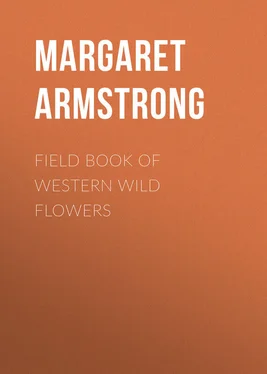Margaret Armstrong - Field Book of Western Wild Flowers
Здесь есть возможность читать онлайн «Margaret Armstrong - Field Book of Western Wild Flowers» — ознакомительный отрывок электронной книги совершенно бесплатно, а после прочтения отрывка купить полную версию. В некоторых случаях можно слушать аудио, скачать через торрент в формате fb2 и присутствует краткое содержание. Жанр: foreign_antique, foreign_prose, на английском языке. Описание произведения, (предисловие) а так же отзывы посетителей доступны на портале библиотеки ЛибКат.
- Название:Field Book of Western Wild Flowers
- Автор:
- Жанр:
- Год:неизвестен
- ISBN:нет данных
- Рейтинг книги:5 / 5. Голосов: 1
-
Избранное:Добавить в избранное
- Отзывы:
-
Ваша оценка:
- 100
- 1
- 2
- 3
- 4
- 5
Field Book of Western Wild Flowers: краткое содержание, описание и аннотация
Предлагаем к чтению аннотацию, описание, краткое содержание или предисловие (зависит от того, что написал сам автор книги «Field Book of Western Wild Flowers»). Если вы не нашли необходимую информацию о книге — напишите в комментариях, мы постараемся отыскать её.
Field Book of Western Wild Flowers — читать онлайн ознакомительный отрывок
Ниже представлен текст книги, разбитый по страницам. Система сохранения места последней прочитанной страницы, позволяет с удобством читать онлайн бесплатно книгу «Field Book of Western Wild Flowers», без необходимости каждый раз заново искать на чём Вы остановились. Поставьте закладку, и сможете в любой момент перейти на страницу, на которой закончили чтение.
Интервал:
Закладка:
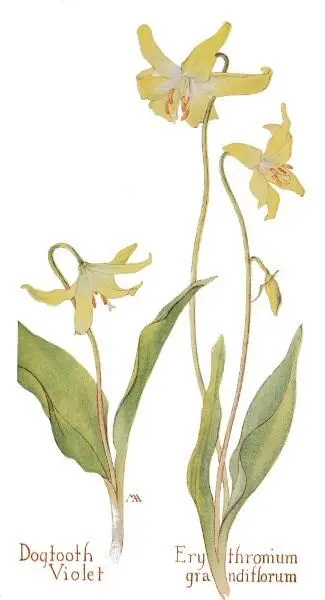
Dogtooth Violet – Erythronium grandiflorum.
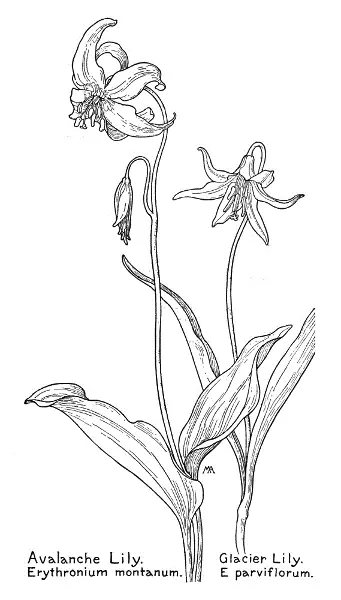
Avalanche Lily – Erythronium montanum.
Glacier Lily – E. parviflorum.

Desert Lily
Hesperocállis undulàta
White
Spring
Cal., Ariz.
This is the only one of its kind, a wonderfully beautiful desert plant, much like an Easter Lily. The stout, pale, bluish stem, from six inches to two feet tall, has a delicate "bloom" and springs from a graceful cluster of narrow leaves, which are a foot and a half long, spreading widely, but not lying quite flat on the ground. They are pale bluish-green, with a narrow, crinkled, white border and folded lengthwise. The buds are bluish and the lovely flowers are about three inches long and pure-white, delicately striped with pale-green and blue on the outside, with yellow anthers and a white stigma, and with a papery bract at the base of each pedicel. The flowers are slightly fragrant and become papery and curiously transparent as they wither. In dry seasons these plants do not bloom at all, but the slightest moisture will cause them to send up a stout stem and crown it with exquisite blossoms, which look extraordinarily out of place on the arid desert sand around Yuma and Ft. Mohave. The bulb is eaten by the Indians.

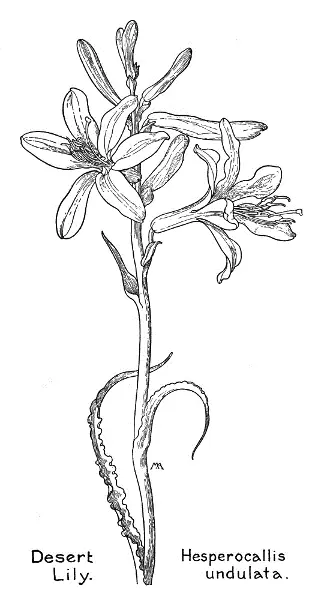
Desert Lily – Hesperocallis undulata.

Lilies, the "lords of gardens," are perhaps the most beautiful and popular flowers everywhere and there are some wonderful ones in the West. They have tall, smooth, leafy stems, springing from scaly bulbs; large showy flowers, solitary or in terminal clusters; smooth, netted-veined leaves, often in whorls, and leaflike bracts. The flower-cup is funnel-formed, or bell-shaped, and has six, equal, spreading divisions, with a honey-bearing groove at the base of each; the stamens, with long anthers, swinging from the tips of long filaments; a long pistil, with a three-lobed stigma and the capsule oblong, with two rows of flat seeds in each of its cells. There are no true Lilies in Utah.
Small Tiger Lily
Lílium párvum
Orange-red
Summer
Cal., Oreg.
These tall plants carry a brilliant crown of small lilies, glowing like jewels in the dark moist woods they love. The stem is from one and a half to six feet high, covered with a slight down that rubs off, and springs from a small bulb with short, thick scales. The long, pointed, rich-green leaves are in whorls of five or six below, more scattered towards the top of the stalk. The flowers are rather more than an inch long, yellow at the base of the petals, shading through orange to vermilion at the tips and dotted with crimson in the throat. Usually there are six or seven in a cluster, but they have been found with many more in favorable situations and single plants in Yosemite have been seen with as many as thirty blossoms. The capsule is roundish and less than an inch long. These little Lilies are among the most attractive of their kind and grow somewhat freely in the high Sierras to an altitude of seven thousand feet and as far north as Oregon.

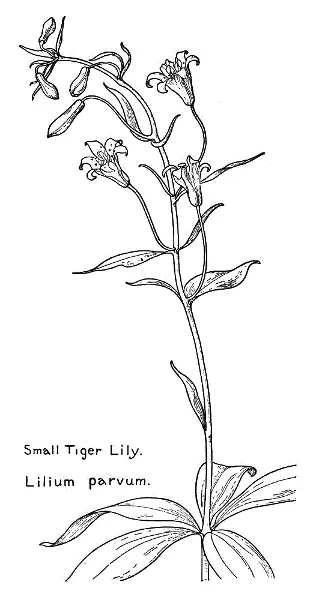
Small Tiger Lily – Lilium parvum.

Washington Lily
Shasta Lily
Lílium Washingtoniànum
White
Summer
Cal., Oreg.
In the Sierras, at an altitude of from three to over seven thousand feet, and as far north as the Columbia River, we may be fortunate enough to find this glorious Lily, growing in the forest in moderate shade and protected by the chaparral. It is not rare but nowhere very abundant. I shall never forget finding a group of three or four, growing near a huge fallen tree, in the woods at Wawona near Yosemite, where it is very fine. Their raiment is even more "white and glistering" than the cultivated Easter Lilies. The smooth, stout, purplish stem is from two to five feet high, adorned all the way up with successive whorls of handsome dark-green leaves, three or four inches long, thin in texture, with rippling margins, and shining as if they had been varnished. There are from two to twenty blossoms of shining white, each one from three to four inches long and as much across. The petals are cleft to the base, spreading wide apart when the flower is fully open, sometimes finely dotted with purple, and becoming purplish in fading. The anthers are yellow and the pistil green, and the bulb is large, with thin scales. The scent is delicious, having a whiff of spicy carnation added to the usual lily fragrance. This is never found in the Coast Range and is the only pure white American Lily. Shasta Lily is a variety with a small bulb. L. Párryi , the Lemon Lily, of southern California and Arizona, is similar in the form of its flowers, which are large and clear yellow, dotted lightly with deeper yellow. It grows in shady, moist spots in cool canyons and is very beautiful.

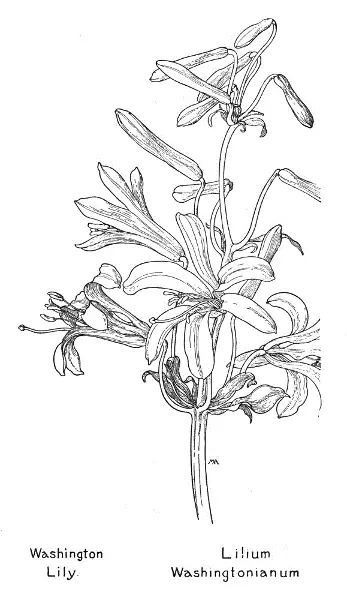
Washington Lily – Lilium Washingtonianum.
Leopard Lily
Lílium pardalìnum
Orange
Summer
Wash., Oreg., Cal.
A magnificent plant, from three to six feet tall, with bright-green leaves, thin in texture, smooth but not shiny, and mostly in whorls. The stem is crowned by a splendid cluster of flowers, usually about half a dozen together, but sometimes as many as thirty on one stalk. They measure three or four inches across and are pale-orange outside and deep-orange inside, spotted with maroon, often blotched with orange-yellow in the throat and tipped with scarlet. The anthers are purplish, changing to reddish-brown, and the pistil is bright-green. These plants often grow in large companies, in moist spots in the mountains, and are unrivaled in decorative beauty and brilliancy of coloring.
Tiger Lily
Lílium Columbiànum
Orange
Summer
Wash., Oreg.
A good deal like the last, but not so large. The petals are more turned back and they are orange-color all over, dotted with dark-red, and the anthers are pale orange-color, ripening to golden-brown. This is common in the Hood River Valley.
Читать дальшеИнтервал:
Закладка:
Похожие книги на «Field Book of Western Wild Flowers»
Представляем Вашему вниманию похожие книги на «Field Book of Western Wild Flowers» списком для выбора. Мы отобрали схожую по названию и смыслу литературу в надежде предоставить читателям больше вариантов отыскать новые, интересные, ещё непрочитанные произведения.
Обсуждение, отзывы о книге «Field Book of Western Wild Flowers» и просто собственные мнения читателей. Оставьте ваши комментарии, напишите, что Вы думаете о произведении, его смысле или главных героях. Укажите что конкретно понравилось, а что нет, и почему Вы так считаете.
